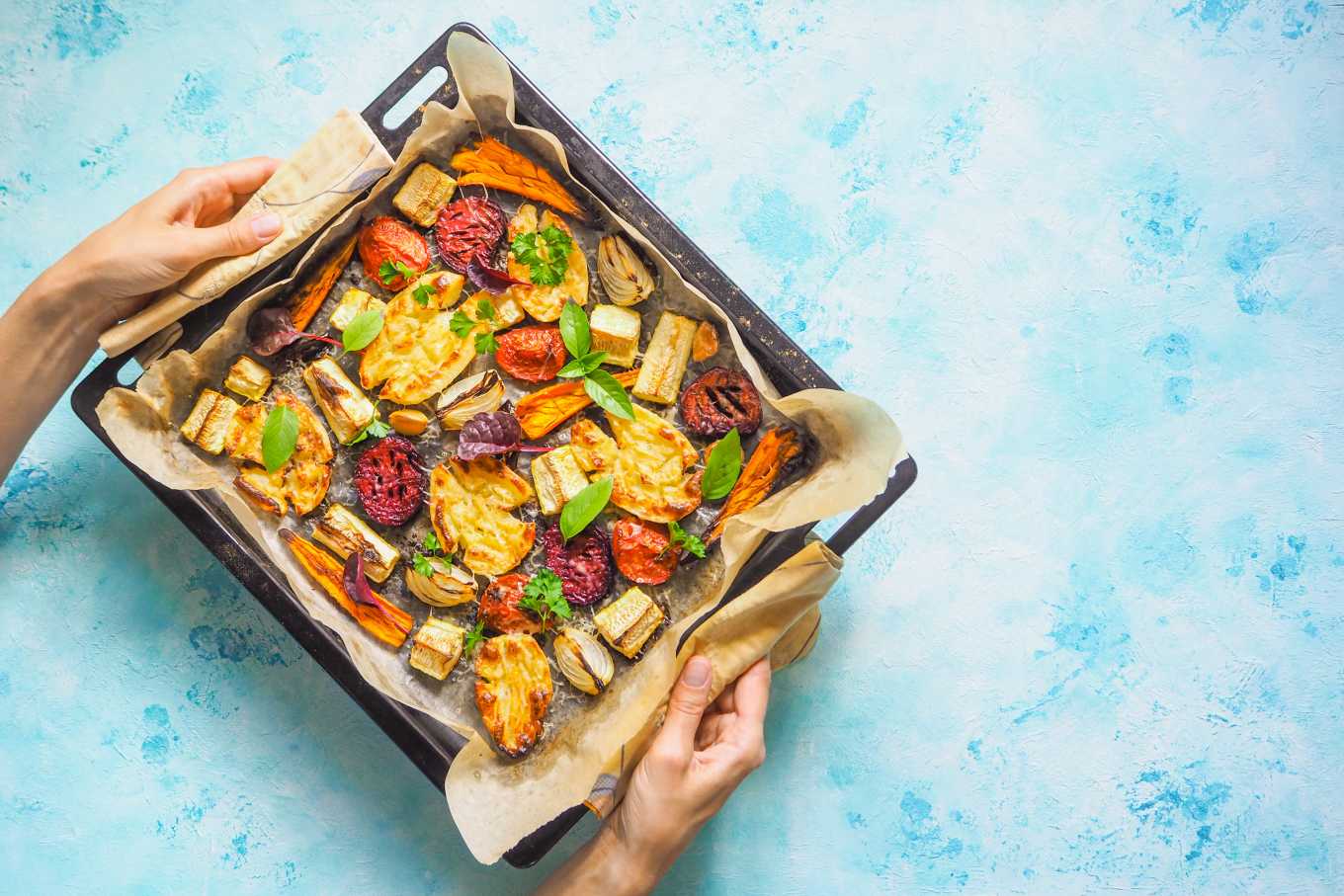6 Tips to make quick and healthy sheet pan dinners
- 3 Minutes Read
It's a snap to make healthy sheet pan dinners. Who doesn’t love the idea of a complete meal on the table, with minimal cleanup? Here’s what you need to know for successful, easy one-pan meals.
Veggies shine in sheet pan meals by adding sweetness and depth of flavor from caramelization, plus extra crispiness from roasting. When prepared this way, vegetables become a highlight of the meal instead of an afterthought. Healthy sheet pan dinners provide a nice balance of protein, veggies, and healthy fats, leaving you satisfied but not sluggish.
Cooking everything on one pan means simple cleanup. No expensive equipment is needed since all you need are one or two sheet pans. The standard size for home cooks is 18x13 inches (46x33 cm) with a one-inch (2.5 cm) rim, (a.k.a “half-sheet”). If you are cooking for one or want to cook some items separately, smaller pans (9x13 inches or 23x33 cm) may be useful.
These any-night-of-the-week meals offer ultimate flexibility, allowing you to use whatever is in the fridge or freezer or highlight what is in season or on sale. Mix and match protein and veggies with optional starches, and you have a healthy meal that can suit any eating plan, from low-carb, Mediterranean, to vegetarian.
Successful sheet pan baking relies on a higher temperature. Most recipes call for a 400-450F (205-230C) oven. Since oven temperatures can vary significantly, consider using an oven thermometer to better gauge your oven's actual temperature.
Note: Some recipes call for preheating the sheet pan—double-check before you begin.
Good protein options for sheet pan cooking include:
Optional: Soak the protein in your favorite marinade for 20-30 minutes before cooking.
Note: Protein cooking time can vary widely, depending on the texture and size of the pieces. If you are concerned about a mismatch between protein cooking time and veggies, cook them in separate pans or add the components at different times. You may also pair longer-cooking proteins with longer-cooking veggies (e.g., bone-in chicken thighs with sweet potatoes) and faster-cooking proteins with faster-cooking veggies (e.g., shrimp with asparagus).
Select a variety of veggies based on the color, texture, and flavor you wish to add.
Excellent veggie options include:
Tips:
Dry the veggies well to promote roasting, not steaming.
Cut vegetables into similar sizes so they cook uniformly.
For a veggie bonus, toss in leafy greens such as spinach at the end of cooking, allowing greens to wilt slightly.
Even if you prefer low-fat cooking, don’t omit the oil entirely–it promotes browning and even cooking. Add enough oil to coat the protein and vegetables lightly. Olive oil is the go-to for healthy sheet pan cooking, but avocado or canola oil are good alternatives. For easier cleanup, line the pan with parchment paper. However, the more your sheet pan gets used, the more, it will become stick-resistant.
Add herbs and spices you like. Fresh, hearty herbs such as rosemary, thyme, and sage hold up well to the high temps of sheet pan cooking. Save tender fresh herbs, such as basil and chives, for the end of cooking time. Season with salt and pepper to taste, knowing you can always add more later.
Tip: To minimize cleanup, toss the veggies and protein with oil and herbs directly on the pan instead of in a bowl.
Spread your mixture of vegetables and protein onto the sheet pan. Leave space between the veggies to allow them to roast properly. Some recipes suggest roasting proteins on one end and vegetables on the other end of the pan, so check first.
Place the pan in the oven and enjoy the freedom of cooking a meal that doesn’t require constant attention. Cooking times vary depending on the density of the food but will generally be about 20-40 minutes. About 10 minutes into the cooking time, flip everything over for even browning. Items toward the edges of the pan cook faster; you may want to rearrange items at this time, also.
Liven up your meal with a drizzle of fresh lemon juice, balsamic vinegar, or tahini. Top with fresh herbs for additional flavor and visual appeal.
If desired, serve your creation with whole-grain pasta, quinoa, farro, or brown rice. Store leftovers in the fridge for up to three days.
The flexibility of sheet pan meals allows you to put a healthy dinner together with no recipe required. Yet, if you are just starting, following a recipe will help you master the technique. Once you make your own creation, enter it as a Custom Recipe in MyNetDiary for easy tracking.
Our favorite healthy sheet pan dinner recipes in MyNetDiary’s Premium Recipe collection include Sheet Pan Sweet Potato Hash with Eggs, Sheet Pan Baked Salmon with Roasted Potatoes and Green Beans, and Sheet Pan Shrimp and Peppers.
You can also search “sheet pan” in MyNetDiary’s extensive Recipe Database to find numerous appealing recipes.
Adapted from original content from Matha Henze.
Still new to MyNetDiary? Learn more today by downloading the app for FREE.
Foods & Recipes->Fruit & Vegetables Meal Planning & Diets->Dinner